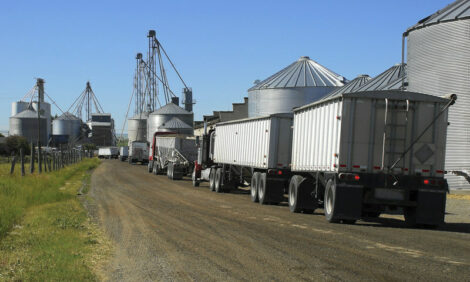



Pork Commentary: Corn and soybeans Come Down
CANADA - Iowa-Minnesota closed last Friday at 51.18 lean and with breakevens near 75¢ (at current feed costs). We are seeing losses of $40.00 a head plus. It’s ugly, and it’s painful, says Jim Long.
We usually can find something positive but right now we are the boy that’s sure there’s a pony in the manure pile. We are hoping and searching for positive news.
Searching
- Soy meal came down $40.00 a ton last week. This will lower breakevens for all producers. Brazil is harvesting and yield reports are good, which is negative for the soybean market. Let’s hope the Brazilians got a bumper crop.
- USDA is projecting 17 million more acres of grains and oilseeds to be planted in 2008 compared to 2007. No one is sure how much corn, wheat, soybean will be planted but an extra 17 million acres, with much of it conservation ground, will increase feed availability. We expect everywhere in the Northern Hemisphere will be the same – Europe, Russia, Ukraine, Canada, Mexico, China, etc. Record prices for crops will find more acres to plant. High prices always cure high prices.
- Packers continue to handle market hogs, as capacity was not an issue last week. 2.227 million; up 4.9% from a year ago but thankfully lower than the 10% extra we have been averaging week upon week.
- We have been saying for the last year and a half that more small pigs would be coming from Canada. We now believe that the numbers will begin to stabilize. Lower feed costs in Ontario will keep that region’s pig export numbers from growing. Packer capacity is coming in line with Canadian market inventories. Also, the availability of US small pig contracts to purchase or finish is not increasing. Some packer reluctance to offer contracts for Canadian origin pigs beyond the fall due to Country of Origin Labeling is also slowing market entry.
- These low prices are encouraging producers to cut back. We expect many sow units’ inventory will be declining. Reluctance to purchase or place gilts for cash flow reasons will be lowering individual sow units’ inventory. We could be wrong but we suspect the attrition is taking a toll. It’s hard to maintain sow inventories in a breeding herd and when things are tough it’s even harder, as it takes commitment and resources. Fewer sows mean fewer pigs.
- Pork in cold storage last month was up 5% from last year. Considering the pork tonnage of the last 6 months of way over 2 million plus a week kills, it’s a real positive sign. Pork is moving. Demand is good. Get our weekly kills down to 2 million head and prices will be $40.00 a head better than they are now.
Other News
- Smithfield Foods announced the sale of their beef division. They want to concentrate on hog and pork production. Give Smithfield credit – they know their core business. We expect low hog prices have hit Smithfield like every other producer. They market 18 million hogs a year. There is no magic; the corn price is the corn price, meal price is the meal price and the hog market is the hog market. Smithfield feels the pain we all feel. They, like us all, need lower feed costs and higher hog market prices. Smithfield has announced liquidation of 50,000 sows, Hormel Foods 9,000 sows. There is liquidation underway beyond these two large pork powerhouses. It will happen. The hog cycle lives.
- How bad is it? Had calls this week from people suggesting in forming producer cartel to set hog prices? Calls from people wanting to limit carcass prices? Calls from people wanting to limit carcass weights? Buyers with small pig contracts running away from their commitments? It’s nasty and in our opinion these are all indications of hog cycle bottom.
Summary
Corn and soybeans came down in price last week. We expect their prices could have peaked unless there is a drought. Lean hog prices are languishing but we all know lean hog futures in June are 74¢ or $44.00 a head better than now. It gives us hope. We know the hog cycle is alive and well. We are all being hurt. We believe liquidation is happening to an extent prices will be 90¢ lean by the first part of 2009. The world meat protein reduction due to low prices and high feed prices will create extraordinary export opportunities for pork.








